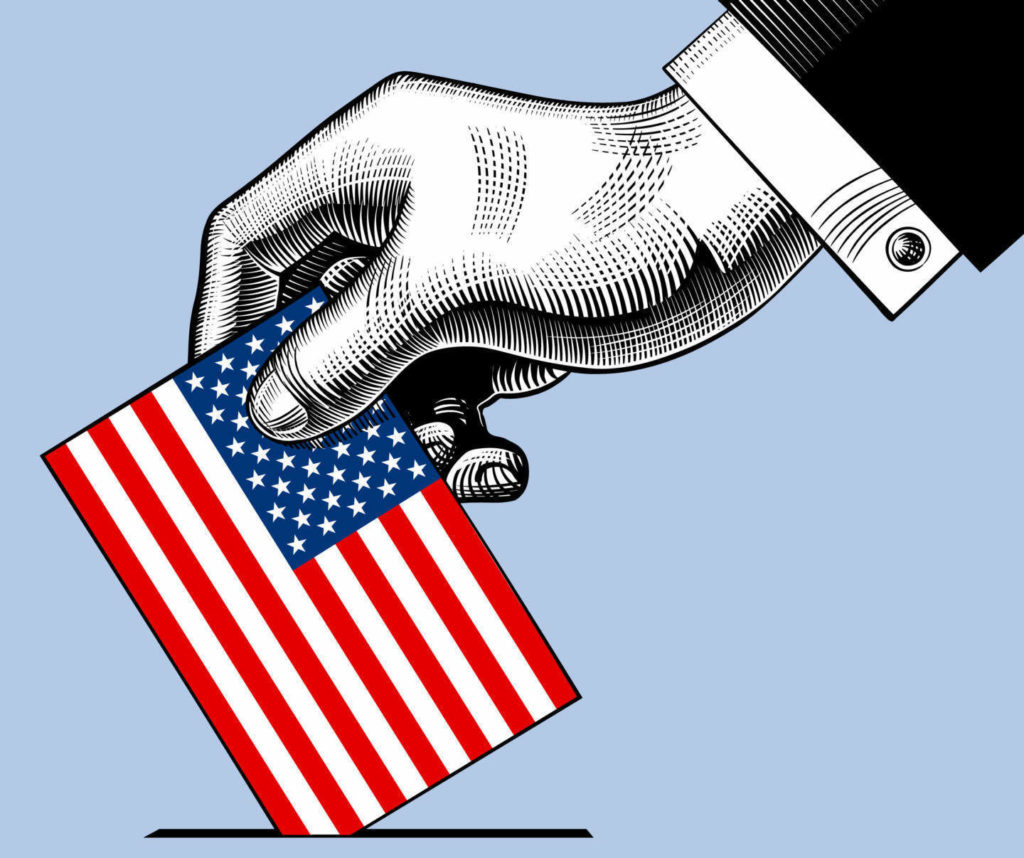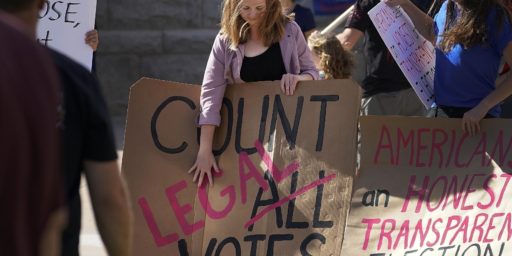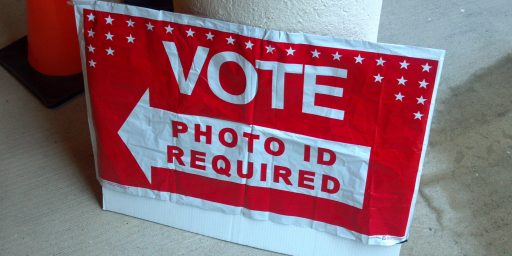Myths of American Democracy
Tweaking the message and getting out the vote don't matter as much as strategists think.

Veteran political scientist Ruy Teixeira decries the fact that “Turnout Myths Are the Democrats’ Drug of Choice.” The entire essay is worth a read but I want to draw your attention in particular to this passage:
Some Simple Math. Start with this: when Democrats persuade a voter to switch sides, that nets two votes for the Democrats (one less for the Republicans, one more for the Democrats). When Democrats turn out one more voter to vote Democratic that is, of course, a net of only one vote for them.
But it’s really worse than that. Typically, Democrats think of increased base turnout in terms of turning out more voters from various pro-Democratic demographic groups—young voters, black voters, Hispanic voters, college-educated whites, whatever. But not all the voters in these groups favor the Democrats so mobilization of more voters from a given group may well net less than one vote per additional voter. For example, looking at current Congressional ballot preferences, Democrats might net only a third of a vote for every additional Hispanic or young voter, six-tenths of a vote from every additional black voter and just a sixth of a vote from every additional college-educated white voter.
The math looks even more unfavorable when the following is considered: Democrats tend to assume that nonvoters from a given demographic are the same politically as voters from the same group….except they don’t vote. But a mountain of political science evidence shows that’s not so. Nonvoters, controlling for demographics, tend to be less ideological and, very importantly, if they do vote tend to swing in the direction of the prevailing political environment—which of course is currently terrible for the Democrats and likely to be so on election day. This means the “yield” for the Democrats from higher turnout could be even less than the data above indicates.
Finally, the general assumption seems to be that an aggressively polarized election will juice turnout among Democratic-leaning constituencies….but (somehow) not on the other side. That’s not the way it works. The other side gets to vote too so dialing it up to 11 on the Democratic positions may mobilize the other side just as much—maybe more!—than the left’s side. Once again, the basic math on the turnout-driven strategy is much less favorable than most Democrats assume.
The reasoning behind the myth is logical enough: there are considerably more self-identified Democrats in the populace than self-identified Republicans but the latter is formed by constituencies more likely to actually show up to vote. Indeed, lots of Republicans have bought off on the idea as well, which is why its leaders in so many states and localities want to put up obstacles to voting.
To the extent this is true, though, it probably makes more sense to address is by things like voter registration drives in Democrat-friendly precincts, free shuttles to polling places from Black churches, and the like rather than television ads that are seen by potential Republican voters, too.
Amusingly, Teixeira ends his piece by relying on some mythology himself:
As I have noted previously, Democrats may be better off accepting they will take their lumps in 2022 (while attempting to minimize the damage) but use the election as a teachable moment. That teachable moment should be, above all, about re-acquainting the party with the actually-existing demographics and politics of the country they live in. Given patterns of educational and geographic polarization, they are now at a crippling disadvantage in what remains an overwhelmingly working class and non-urban country. There are simply too many districts and states in the country where polarization redounds to their disadvantage and makes them uncompetitive. That is not a problem that can be solved by “mobilizing the base”. It calls instead for expanding your coalition by persuading more working class and non-urban voters you share their values and priorities.
As with the turnout myth, this is based on a reasonable premise: the white working-class base that was an integral part of the FDR coalition has steadily moved to the GOP since the late 1960s. But the notion that simply changing messaging will persuade them to come back any time soon is unfounded.
First, it assumes that mass numbers of people are persuadable by campaign rhetoric rather than committed partisans who will stick with their team absent something truly earth-shattering. Second, rather obviously, shifting the Democratic Party’s agenda to appeal to them would drive off existing voters with very different interests. Third, the electoral districts that will be used in November will be with us another decade and most of them are drawn to extreme partisan skew.
Obviously, despite the considerable obstacles, realignments happen from time to time. Sometimes, seismic events—the Great Depression, the Civil Rights movement—shift the ground. Mostly, though, it’s the slow process of older generations dying off and being replaced in the voter pool by younger generations with different outlooks and interests.






Yes to that, with a qualifier. Working class whites that are as young as their 40’s are entrenched members of the R coalition so waiting for generational change will be a long time and after much damage and even then, there are no guarantees. As has been discussed here, Dem elites have a top down perspective on effecting political change that has proven to be a failure, even if the policies that Dems propose poll well.
The alternative is to build from the bottom up, which means competing in local elections in solid red counties and getting your head handed to you. It also means listening to those voters and incorporating what they feel is important and crafting policies that reflect white working class views in the context of Dem values.
Will it take a long time? Yup. The R takeover of the south took the better part of 30 years and they had the assistance of a Dem party that all but abandoned the region.
Of course Dems being Dems are more likely to sleepwalk into an R authoritarian America arguing about pronouns and talking about how their esteemed R brethren.
This is a favorite hobby horse of Teixeira. But it’s he — not Democrats — who sees voter cultivation as a zero sum choice between growing the base vs persuading swing voters. The Democratic Party position, which he endiessly misrepresents, is that winning more votes is a both/and not either/or proposition.
Voting rights activists among Georgia Democrats came up with a plan ten years ago to cultivate and turnout Democratic-leaning nonvoters. This plan has been wildly successful. Teixeira never talks about that because it does not fit his preferred narrative.
And this is just odd:
I realize the Very Serious People inside the Beltway cannot think critically or creatively past their breathless “Democrats Are Always Doomed, Republicans Are Always Winning” double standards, but facts do matter.
It’s a fact that Democrats have won the presidential popular vote in every such cycle except one over the past three decades. That the White House, Senate, and House have flipped blue since 2016. That Georgia and Arizona, both reliably red once, are now Biden-voting swing states with two Democratic senators each. That the latest polling shows Democrats with comfortable 2022 statewide race leads in Pennsylvania and Nevada. That the youth voters who will shortly dominate US politics, while perhaps disappointed in Democrats, are outright hostile to the Republican Party at supermajority numbers.
Does Teixeira have a secret definition of “crippled” that I don’t know about? 2022 won’t be a banner year for Democrats, but he really needs to stop the hysterics and calm down.
As quoted in the OP (emphasis mine)
The most significant issue in understanding our politics is that the distribution of voters as linked to the lines we draw is a more important explanation of election outcomes than turnout or message (or candidate quality).
Teixeira’s argument is that Ds focus on driving turnout of ethnic groups and that non-voting ethnics are, on average, less D than their fellows who do vote. I’m not, for the sake of a blog comment, going to dive into the linked 300+ page paper to check his arithmetic. But as in economics, it’s the margin that counts, the voters most easily persuaded to vote. One suspects their partisan inclination may be closer to the voters than the average non-voter.
In any case, turnout need not be ethnic group focussed. Biden won largely because he carefully avoided triggering negative partisanship which would drive R turnout while allowing negative partisanship toward TFG to drive D turnout. This would selectively encourage D learners. Rove said all prez elections are now turnout elections. He was a raging arsehole, but that doesn’t make him wrong.
Teixeira also neglects, as discussed often in these threads, the difficulty of flipping voters. A flipped voter may be worth 2 votes, while a turned out Black nets, per Teixeira, only 0.6 votes. But if $X will turnout a Black voter, but it takes $4X to flip an R, you go for turnout.
It needs a much longer treatment, but I wonder what would happen if Ds actually went for enthusiasm and turnout. As is they present mostly as a bunch of career pols whose only virtue is they’re not quite as bad as the other guys. I’m a lifetime D voter and I can’t tell you what Ds actually stand for. They’ve done nothing on guns, or AGW, or voting rights, or economic inequality. Damnit, do something. You may not win, but FFS fight. For which see Bernie’s op ed in The Guardian yesterday.
@gVOR08:
In 2020 Biden received ~83M votes, the most in the history of presidential elections, TFG received ~75M, the second largest vote total in history. Getting 5M more Californians and vote D, or increasing our vote totals in NY or MA to vote, won’t move the needle for Dems one iota. As @Steven L. Taylor: points out, the issue the distribution of federal offices and the electoral college. At the end of the day, flipping voters and congressional districts and then states, is the only way for Dems to become competitive, that was the insight that Howard Dean had, that the party has chosen to ignore. Otherwise we are a boutique urban/suburban party.
edit
@Sleeping Dog: Notice that Howard Dean came from a small rural state. He knew that you had to have a 50 state campaign.
The short answer is that the Democrats should be running guys like Fetterman. They need chill and relaxed. They can not outdo the Republicans in hysteria and borderline personality disorder grimness. The beltway dorks like Texeira (just google how his picture) who have an ideal Clinton-era rube slopping up anti-welfare rhetoric in their minds when they think of the working class are doing a disservice to actual humans in this country.
The long answer is that hysteria and grimness are part of the American deal. And it’s not just the red state voters. This anti-trans stuff seems to live in the unconscious of college-educated voters who believe that teens think it’s so cool to be trans. At the same time, there’s no great wave coming of popular change. The GOP could receive 50.00001% of the popular vote and that will be treated as the second coming of Nixon and Reagan. All of this forces that have given us Latinx and Defund and whatever else terrifies the masses are going to be around and more normal, rather than less. My big fear is that 50.00001% is going to give the GOP a chance to turn the culture war into the War on Drugs. They’re not going to stop gay people from being gay and queers from being queer and if abortion is outlawed everywhere you are going to see a vast amount of rebellion, but the War on Drugs wasn’t fought to be won.
I believe there is a grain of truth in all of the above responses. The following observations are drawn from my career as a systems analyst for government and private sectors.
1. A proposed solution is not the problem.
Most recent example: Arm teachers rather than sorting out why unstable people can easily and legally acquire weapons for mass murder.
2. If motivated to vote, people will ALWAYS vote based upon what they fear regardless of what they say publicly.
Most recent example: I need an AR-15 and carry to be safe.
Republicans have an inherent advantage because they appeal to people who fear, e. g., infringement upon personal freedom; gun control, the sin of abortion; immigrants and people of color; the lie that not everyone is heterosexual and born with sexual organs that match their gender; etc.
Democrats have a disadvantage because their definition of problems and solutions are more hopeful, progressive, and difficult link with immediate problems of everyday life: a functioning democracy; environmental protection for long-term survival; education for long-term economic well-being; support for people of color and non-straight folks or those with gender dissonance who want to feel safe and authentic; addressing the nonlinear threat of climate warming and avoiding the tipping point where humans cannot reverse the trend; etc.
If Democrats want to get more people to vote or vote differently, they need to describe in explicit terms how long-term problems will reduce the quality of life for everyday Americans in the immediate future and in 5, 20, 15, 20 years if they don’t adopt Democratic policies and platforms.
Bill Clinton was a master at this.
2. If people don’t like you (the collective and personal you), they won’t support you.
Most recent example: I’m voting for Trump because he isn’t Hillary.
The extreme far-right don’t like anyone who isn’t extreme far-right. The extreme far-left doesn’t like anyone who isn’t extreme far-left. Trying to change their votes is like a waste of time and energy. Remember support for Nader and the Green Party in 2000?
3. People who view politics as vulgar or not relevant to their well-being tend to not vote. Until they perceive a specific existential threat to their well-being, they will not pay attention and vote. Politicians must define platforms and choose candidates at all levels of government that effectively (and as simply as possible) translate issues into solutions for short-and long-term well-being.
4. Maintaining a knowledge-based organization (i. e., electorate) is a long-term and perpetual task.
Most recent example: More Americans are willing to accept authoritarianism because they haven’t learned about what life is like under authoritarian regimes.
Organizations who successfully implement a complex, knowledge-based solutions tend to fail two times before they get it right. Internal politics and lack of comprehensive problem analysis, long-term vision, and employee knowledge are all factors.
America has failed with the (1) overturning of Citizens United and (2) rise of Donald Trump and the corruption, bigotry, ultra-partisanship, and authoritarian tendencies he unleashed.
We must use every legal and ethical means to remind the public of our American history and of lessons learned to raise their fear about the threat to American democracy, increase their knowledge about issues, and get them vote.
And finally, as a hat tip to Steven, I draw upon my experience in Red America.
How jurisdiction and political district lines are drawn does define the efficacy of one’s vote. The local Democrats got hot and bothered after Trump won in 2020 and focused on getting out the vote, only to learn that we were completely unable to effect the outcome of local and state elections. My personal take: We need to change our strategy from voter turnout to communicating how the Democratic policies can help solve local rural problems with the hope that we can attract more people to the party in 10 years.